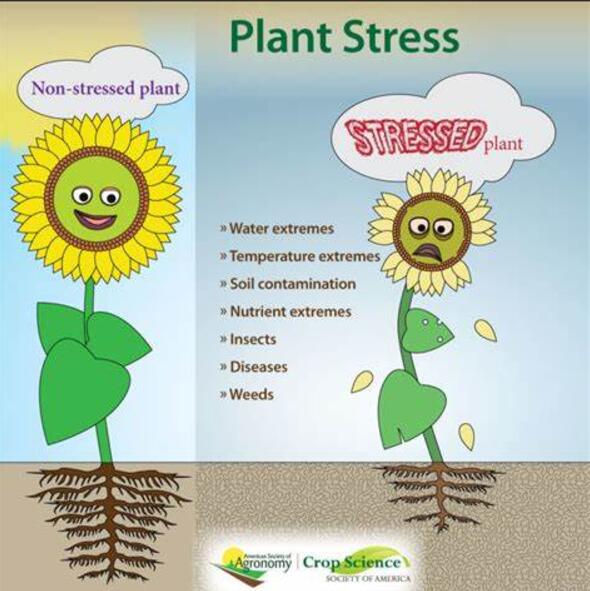干旱胁迫下 B. oleracea L. var. italica 和 B. macrocarpa Guss. 基因型的转录组比较分析:全新基因组组装与参考基因组组装对比
IF 6.8
Q1 PLANT SCIENCES
引用次数: 0
摘要
干旱胁迫会影响植物的生长和发育,影响生长周期中的一些生理过程。提高植物的抗旱能力可以减少作物对水的需求,这也是当前气候变化给农业带来的新挑战。对有助于减少用水量和提高植物抗旱能力的遗传特征进行个性化研究,将是为预计的全球人口增长提供足够粮食的关键战略之一。如今,由于每种作物都经过驯化过程,现代农业使用的栽培品种显示出狭窄的遗传多样性,导致对受抗逆活动和气候变化影响的环境条件的适应性较差。在几种种植的作物中,芸苔属植物(n = 9)特别容易受到缺水的不利影响。转录组分析是一种功能强大的工具,研究人员通过它可以确定基因和通路,这些基因和通路在应对每种特定压力时被激活或抑制,从而阐明相应反应的复杂调控网络。为了确定差异表达的基因,我们比较了在普通灌溉制度和缺水条件下生长的两个对干旱敏感的 B. oleracea L. var.通过 RNAseq 方法获得了它们的转录组。经鉴定的抗旱基因型和耐旱基因型在 H2O2 含量、叶面积和 SPAD 指数(土壤植物分析发展指数)方面存在显著差异。为了更好地确定与敏感基因型和耐旱基因型的干旱胁迫响应相关的关键基因和通路,对从头组装和参考 B. oleracea var.通过对转录组的比较,我们确定了与甘蓝型油菜作物对干旱胁迫的耐受性相关的关键基因和途径。主要结果是,我们发现一个编码转录因子的基因在敏感和耐受特征中表现出相反的行为。采用两种转录组组装方法提供了一个更全面的数据集,从而能够对结果做出无偏见的解释。本文章由计算机程序翻译,如有差异,请以英文原文为准。
Comparative transcriptome analysis of B. oleracea L. var. italica and B. macrocarpa Guss. genotypes under drought stress: de novo vs reference genome assembly
Drought stress influences plant growth and development affecting some physiological processes during the growing cycle. The improvement of the drought stress resistance of the plant will allow the reduction of the water requirements of the crops, representing the new frontier for agriculture, as consequence of the ongoing climatic changes. The individuation of genetic features useful for enhancing the reduction of water use and the plant drought resistance will be one of the key strategy for providing enough food for the foreseen increment of the global population. Nowadays, the cultivars used for modern agriculture show a narrow genetic diversity due to the domestication process carried out of each crop, resulting with a less adaptation to the environmental conditions affected by both antropic activities and the climatic change in act. Among the several grown species, Brassica oleracea L. (n = 9) crops are particularly vulnerable to the adverse effects of water deficiency. Transcriptomic analysis is a powerful tool that allows researchers to identify genes and pathways, that are activated or repressed in response to each specific stress, elucidating the complex regulatory networks that underlie the correspondent response. To individuate the differentially expressed genes we compared two drought-sensitive B. oleracea L. var. botritis x italica Sicilian landraces and two drought-tolerant B. macrocarpa Guss populations grown in ordinary irrigation regimes and in water deficit conditions. Their transcriptome was obtained by a RNAseq approach. The individuated sensible and tolerant drought stress genotypes showed significant difference for H2O2 content, leaf area and SPAD index (Soil Plant Analysis Development). For better identify crucial genes and pathways associated with drought stress response of both the sensible and tolerant genotypes a thorough evaluation of both de novo assembly and reference B. oleracea var. italica genome-based assembly was conducted. The comparison of the transcriptomes allowed to identify the crucial genes and pathways associated with tolerance to drought stress in Brassica oleracea L. crops. As main results, we individuated one gene coding transcription factor showing opposite behavior in the sensitive and tolerant signatures. The adoption of two transcriptome assembly methods provided a more comprehensive dataset, enabling an unbiased interpretation of the outcomes.
求助全文
通过发布文献求助,成功后即可免费获取论文全文。
去求助
来源期刊

Plant Stress
PLANT SCIENCES-
CiteScore
5.20
自引率
8.00%
发文量
76
审稿时长
63 days
期刊介绍:
The journal Plant Stress deals with plant (or other photoautotrophs, such as algae, cyanobacteria and lichens) responses to abiotic and biotic stress factors that can result in limited growth and productivity. Such responses can be analyzed and described at a physiological, biochemical and molecular level. Experimental approaches/technologies aiming to improve growth and productivity with a potential for downstream validation under stress conditions will also be considered. Both fundamental and applied research manuscripts are welcome, provided that clear mechanistic hypotheses are made and descriptive approaches are avoided. In addition, high-quality review articles will also be considered, provided they follow a critical approach and stimulate thought for future research avenues.
Plant Stress welcomes high-quality manuscripts related (but not limited) to interactions between plants and:
Lack of water (drought) and excess (flooding),
Salinity stress,
Elevated temperature and/or low temperature (chilling and freezing),
Hypoxia and/or anoxia,
Mineral nutrient excess and/or deficiency,
Heavy metals and/or metalloids,
Plant priming (chemical, biological, physiological, nanomaterial, biostimulant) approaches for improved stress protection,
Viral, phytoplasma, bacterial and fungal plant-pathogen interactions.
The journal welcomes basic and applied research articles, as well as review articles and short communications. All submitted manuscripts will be subject to a thorough peer-reviewing process.
 求助内容:
求助内容: 应助结果提醒方式:
应助结果提醒方式:


